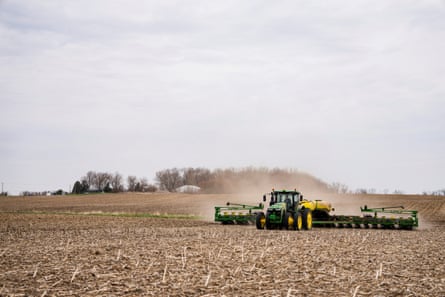Thousands of employees at the US Department of Agriculture will be forced to take salary cuts and relocate out of the Washington DC area, as part of a major restructuring that experts warn will further weaken support for American farmers and complicate wildfire response.
In a memorandum issued on Thursday, the agriculture secretary, Brooke Rollins, outlined the “key pillars” behind the department’s reorganization, focused on reducing its financial footprint, removing resources from the capital, eliminating management and consolidating workforces responsible for a range of functions, including freedom of information requests, tribal relations, grants and human resources.
More than half of employees working in the Washington DC area will be relocated to five locations – Raleigh, North Carolina; Kansas City, Missouri; Indianapolis, Indiana; Fort Collins, Colorado; and Salt Lake City, Utah. Several key USDA offices will be shuttered in the capital region.
The move follows wide-ranging and often chaotic cuts to staff and services being implemented under Trump 2.0, as the administration seeks to dismantle the federal government and fund tax cuts for the wealthy including the president’s billionaire donors.
“President Trump was elected to make real change in Washington, and we are doing just that by moving our key services outside the Beltway and into great American cities across the country,” Rollins said in the statement. “We will do so through a transparent and commonsense process that preserves USDA’s critical health and public safety services the American public relies on.”
In a video call, Rollins informed USDA staff that they would be advised about new assignments – and homes – over the next few months.

More than 90% of the department’s almost 100,000 employees are already based in county and regional offices, including at regional research institutions, farm loan offices and conservation facilities. The reorganization will leave only 2,000 of the current 4,600 USDA staff in the Beltway.
The department will also eliminate or scale down regional offices, combining them into “hub locations to the greatest extent possible”, according to the memo.
Rollins said that the changes would help the USDA better serve its “core constituents” of farmers, ranchers and US producers, focus on the administration’s priorities and eliminate management layers and bureaucracy.
But experts warned that the latest cuts and consolidation of key departments focused on civil rights and small and disadvantaged businesses will further hamstring the agency, which is already reeling
The latest upheaval follows widespread cuts to Biden era agricultural programs, research grants and staff across the country, which along with Trump’s tariff chaos and deepening climate chaos has caused panic among many farmers.
In a written statement, Amy Klobuchar, the Democratic ranking member of the Senate agriculture, nutrition and forestry committee, condemned the plan as a “half-baked proposal” and called for USDA officials to appear before Congress.
“A reorganization of this scale will impact USDA’s ability to provide critical services to Americans and undermine the agency’s trusted expertise that farmers and families count on … we must have an immediate hearing before more damage is done.”
“Today’s move further guts the government’s ability to protect public health, the environment and food safety. The real-world consequences will be severe, directly affecting people’s lives,” said Rebecca Wolf, senior policy analyst at Food & Water Watch Senior Food, a non-profit research and advocacy group.
The reorganization is at least partly a cost-cutting measure, according to Rollins, and the relocated staff could see significant salary reductions due to lower rates paid outside the capital due to difference in the cost of living.
But details were scant on how the plan will unfold, especially when it comes to management and administration of firefighters at the US Forest Service, an agency housed within the USDA. The USFS, which employs the bulk of the nation’s largest firefighting force, is facing severe staffing shortages, a Guardian investigation found this week, as wildfires rage across the country.
Rollins emphasized that the plan will ensure continued support for fire operations and other activities critical to the department’s mission, but there are concerns that further workforce cuts and administrative focus lost to the reorganization during the peak of fire season could have disastrous effects.
As fire risks sharply rise, crews have already begun to feel the impacts from previous cuts to budgets and workers at the agency that support wildfire mitigation and response. The programs incentivized by the Trump administration to sharply shrink the federal government rely on voluntary resignations and early retirements, which undercut the agency’s potential to make strategic decisions about its workforce.
Roughly 1,400 workers with fire qualifications signed on for the programs, leaving holes on teams that play crucial roles in emergency response, especially during the busiest times of the season. Acknowledging the need to backfill these positions, Rollins called for some to return to active duty through the end of the season – only 65 have been reinstated, according to a department spokesperson.
The Forest Service will also see its nine regional offices phased out over the next year and all research stations will be consolidated into one, housed in Fort Collins, Colorado.
Experts were struggling to make sense of the announcement, and shared concerns about how another layer of change could cause more chaos and disorganization as fire risks continue to surge.
“Until we know more specifically about the fire program it’s hard to determine what some of the outcomes of this could be,” said Riva Duncan, a retired USFS fire officer and vice-president of the Grassroots Wildland Firefighters advocacy group. Duncan added that the consolidation of USFS research stations could be problematic because each does fire research and has a focus specific to the landscapes where the station is housed.
“This is another example of decisions being made by people who haven’t bothered to learn or understand the work,” she said.
It is also unclear if the reorganization is designed to align with plans from the Trump administration to combine federal firefighters into a single agency, under the Department of the Interior. Those plans were left in limbo on Tuesday, after the House appropriations committee determined “changes in budgetary and management structure spark concerns about impacted agencies’ abilities to consistently meet critical performance benchmarks”.
A Government Accountability Office (GAO) study was ordered to evaluate the feasibility of the plan, and the House of Representatives adjourned for its August recess on Wednesday, delaying any budget votes until at least September.
More than 15,300 employees have already left the USDA since Trump took office, opting for buyouts and early retirement through the administration’s deferred resignation plan. Similar staff-cutting measures have been implemented across the federal government, overseen by the so-called department of government efficiency, the quasi-government agency created by the billionaire Trump donor Elon Musk.
“This is less a reorganization and more a dismantling. This mass relocation will be costly. It will also result in the mass resignation of staff, which means a major loss of capacity at USDA,” said Ben Lilliston, director of rural strategies and climate change at the Institute for Agriculture and Trade Policy (IATP).
“Contrary to the secretary’s statement, the USDA is already understaffed. There was no effort to get input from Congress, the public or farmers about this reorganization.”
A similar USDA relocation program during the first Trump term led to a smaller, less efficient, less experienced and less diverse workforce, according to the GAO, the bipartisan federal government watchdog.
The USDA workforce grew 8% during the Biden administration, while salaries rose 15%, largely on temporary funding, the department said on Thursday, as Rollins confirmed that the cuts would continue.
“This reorganization is another step of the department’s process of reducing its workforce,” Rollins wrote in the memo, noting that programs to incentivize early retirements and voluntary resignations will continue to reduce the staff numbers further.

 German (DE)
German (DE)  English (US)
English (US)  Spanish (ES)
Spanish (ES)  French (FR)
French (FR)  Hindi (IN)
Hindi (IN)  Italian (IT)
Italian (IT)  Russian (RU)
Russian (RU)  3 weeks ago
3 weeks ago
























Comments